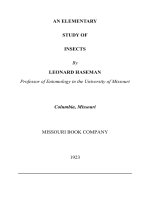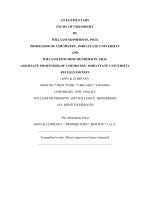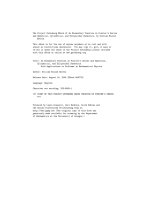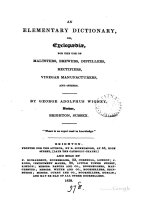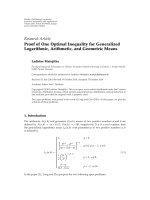AN ELEMENTARY PROOF OF BLUNDON’S INEQUALITY GABRIEL DOSPINESCU, MIRCEA LASCU, COSMIN POHOATA, AND MARIAN TETIVA
Bạn đang xem bản rút gọn của tài liệu. Xem và tải ngay bản đầy đủ của tài liệu tại đây (139.89 KB, 3 trang )
Volume 9 (2008), Issue 4, Article 100, 3 pp.
AN ELEMENTARY PROOF OF BLUNDON’S INEQUALITY
GABRIEL DOSPINESCU, MIRCEA LASCU, COSMIN POHOATA, AND MARIAN TETIVA
ÉCOLE NORMALE SUPÉRIEURE, PARIS, FRANCE.
GIL PUBLISHING HOUSE, ZAL
˘
AU, ROMANIA.
13 PRIDVORULUI STREET, BUCHAREST 010014, ROMANIA.
"GHEORGHE RO ¸SCA CODREANU" HIGH-SCHOOL, BÂRLAD 731183, ROMANIA.
Received 05 August, 2008; accepted 11 October, 2008
Communicated by K.B. Stolarsky
ABSTRACT. In this note, we give an elementary proof of Blundon’s Inequality. We make use
of a simple auxiliary result, provable by only using the Arithmetic Mean - Geometric Mean
Inequality.
Key words and phrases: Blundon’s Inequality, Geometric Inequality, Arithmetic-Geometric Mean Inequality.
2000 Mathematics Subject Classification. Primary 52A40; Secondary 52C05.
For a given triangle ABC we shall consider that A, B, C denote the magnitudes of its angles,
and a, b, c denote the lengths of its corresponding sides. Let R, r and s be the circumradius, the
inradius and the semi-perimeter of the triangle, respectively. In addition, we will occasionally
make use of the symbols
(cyclic sum) and
(cyclic product), where
f(a) = f (a) + f(b) + f(c),
f(a) = f (a)f(b)f (c).
In the AMERICAN MATHEMATICAL MONTHLY, W. J. Blundon [1] asked for the proof of the
inequality
s ≤ 2R + (3
√
3 − 4)r
which holds in any triangle ABC. The solution given by the editors was in fact a comment
made by A. Makowski [3], who refers the reader to [2], where Blundon originally published
this inequality, and where he actually proves more, namely that this is the best such inequality
in the following sense: if, for the numbers k and h the inequality
s ≤ kR + hr
220-08
2 GABRIEL DOSPINESCU, MIRCEA LASCU, COSMIN POHOATA, AND MARIAN TETIVA
is valid in any triangle, with the equality occurring when the triangle is equilateral, then
2R + (3
√
3 − 4)r ≤ kR + hr.
In this note we give a new proof of Blundon’s inequality by making use of the following
preliminary result:
Lemma 1. Any positive real numbers x, y, z such that
x + y + z = xyz
satisfy the inequality
(x − 1)(y − 1)(z − 1) ≤ 6
√
3 − 10.
Proof. Since the numbers are positive, from the given condition it follows immediately that
x < xyz ⇔ yz > 1, and similarly xz > 1 and yz > 1, which shows that it is not possible for
two of the numbers to be less than or equal to 1 (neither can all the numbers be less than 1).
Because if a number is less than 1 and two are greater than 1 the inequality is obviously true
(the product from the left-hand side being negative), we still have to consider the case when
x > 1, y > 1, z > 1. Then the numbers u = x − 1, v = y − 1 and w = z − 1 are positive and,
replacing x = u + 1, y = v + 1, z = w + 1 in the condition from the hypothesis, one gets
uvw + uv + uw + vw = 2.
By the Arithmetic Mean - Geometric Mean inequality
uvw + 3
3
√
u
2
v
2
w
2
≤ uvw + uv + uw + vw = 2,
and hence for t =
3
√
uvw we have
t
3
+ 3t
2
− 2 ≤ 0 ⇔ (t + 1)(t + 1 +
√
3)(t + 1 −
√
3) ≤ 0.
We conclude that t ≤
√
3 − 1 and thus,
(x − 1)(y − 1)(z − 1) ≤ 6
√
3 − 10.
The equality occurs when x = y = z =
√
3. This proves Lemma 1.
We now proceed to prove Blundon’s Inequality.
Theorem 2. In any triangle ABC, we have that
s ≤ 2R + (3
√
3 − 4)r.
The equality occurs if and only if ABC is equilateral.
Proof. According to the well-known formulae
cot
A
2
=
s(s − a)
(s − b)(s − c)
, cot
B
2
=
s(s − b)
(s − c)(s − a)
, cot
C
2
=
s(s − c)
(s − a)(s − b)
,
we deduce that
cot
A
2
=
cot
A
2
=
s
r
,
and
cot
A
2
cot
B
2
=
s
s − a
=
4R + r
r
.
In this case, by applying Lemma 1 to the positive numbers x = cot
A
2
, y = cot
B
2
and z = c ot
C
2
,
it follows that
cot
A
2
− 1
cot
B
2
− 1
cot
C
2
− 1
≤ 6
√
3 − 10,
J. Inequal. Pure and Appl. Math., 9(4) (2008), Art. 100, 3 pp. />BLUNDON’S INEQUALITY 3
and therefore
2
cot
A
2
−
cot
A
2
cot
B
2
≤ 6
√
3 − 9.
This can be rewritten as
2s
r
−
4R + r
r
≤ 6
√
3 − 9,
and thus
s ≤ 2R + (3
√
3 − 4)r.
The equality occurs if and only if cot
A
2
= cot
B
2
= cot
C
2
, i.e. when the triangle ABC is
equilateral. This completes the proof of Blundon’s Inequality.
REFERENCES
[1] W.J. BLUNDON, Problem E1935, The Amer. Math. Monthly, 73 (1966), 1122.
[2] W.J. BLUNDON, Inequalities associated with the triangle, Canad. Math. Bull., 8 (1965), 615–626.
[3] A. MAKOWSKI, Solution of the Problem E1935, The Amer. Math. Monthly, 75 (1968), 404.
J. Inequal. Pure and Appl. Math., 9(4) (2008), Art. 100, 3 pp. />

